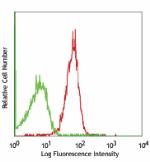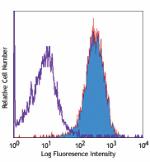- Clone
- Ly9ab3 (See other available formats)
- Regulatory Status
- RUO
- Other Names
- Ly9, SLAMF3
- Isotype
- Armenian Hamster IgG
- Ave. Rating
- Submit a Review
- Product Citations
- publications

-

C57BL/6 splenocytes stained with purified Ly9ab3, followed by anti-Armenian hamster IgG FITC
CD229 is a 100-120 kD glycoprotein. It is a member of the SLAM family, a CD2 subset of the Ig superfamily, known as Ly9 or SLAMF3. CD229 is expressed on T cells, B cells, NK cells, and thymocytes. It functions as a homophilic adhesion molecule through binding to CD229 itself. The cytoplasmic tail of CD229 binds to SAP and Grb2 proteins. CD229 is involved in enhancing T cell activation and Th2 polarization.
Product DetailsProduct Details
- Verified Reactivity
- Mouse
- Antibody Type
- Monoclonal
- Host Species
- Armenian Hamster
- Immunogen
- AHK cells transiently transfected with mouse CD229 (Ly-9)
- Formulation
- Phosphate-buffered solution, pH 7.2, containing 0.09% sodium azide.
- Preparation
- The antibody was purified by affinity chromatography.
- Concentration
- 0.5 mg/ml
- Storage & Handling
- The antibody solution should be stored undiluted between 2°C and 8°C.
- Application
-
FC - Quality tested
- Recommended Usage
-
Each lot of this antibody is quality control tested by immunofluorescent staining with flow cytometric analysis. For flow cytometric staining, the suggested use of this reagent is ≤0.25 µg per million cells in 100 µl volume. It is recommended that the reagent be titrated for optimal performance for each application.
-
Application References
(PubMed link indicates BioLegend citation) -
- Romero X, et al. 2005. J. Immunol. 174:7033.
- Product Citations
-
- RRID
-
AB_830722 (BioLegend Cat. No. 122901)
Antigen Details
- Structure
- 100-120 kD glycoprotein, SLAM family, CD2 subset of Ig superfamily
- Distribution
- T cells, B cells, NK cells, thymocytes
- Function
- Homophilic adhesion, T cell activation, Th2 cell polarization
- Ligand/Receptor
- CD229
- Cell Type
- T cells, B cells, NK cells, Thymocytes
- Biology Area
- Immunology, Innate Immunity
- Molecular Family
- Adhesion Molecules, CD Molecules
- Antigen References
-
1. Sandrin MS, et al. 1996. Immunogenetics 43:13.
2. de la Fuente MA, et al. 2001. Blood 97:3513.
3. Romero X, et al. 2005. J. Immunol. 174:7033.
4. Martin M, et al. 2005. J. Immunol. 174:5977.
5. Graham DB, et al. 2006. J. Immunol. 176:291. - Gene ID
- 17085 View all products for this Gene ID
- UniProt
- View information about CD229 on UniProt.org
Related FAQs
Other Formats
View All CD229 (Ly-9) Reagents Request Custom Conjugation| Description | Clone | Applications |
|---|---|---|
| Purified anti-mouse CD229 (Ly-9) | Ly9ab3 | FC |
| Biotin anti-mouse CD229 (Ly-9) | Ly9ab3 | FC |
Compare Data Across All Formats
This data display is provided for general comparisons between formats.
Your actual data may vary due to variations in samples, target cells, instruments and their settings, staining conditions, and other factors.
If you need assistance with selecting the best format contact our expert technical support team.
-
Purified anti-mouse CD229 (Ly-9)

C57BL/6 splenocytes stained with purified Ly9ab3, followed b... -
Biotin anti-mouse CD229 (Ly-9)

C57BL/6 mouse splenocytes stained with biotinylated Ly9ab3, ...








Follow Us